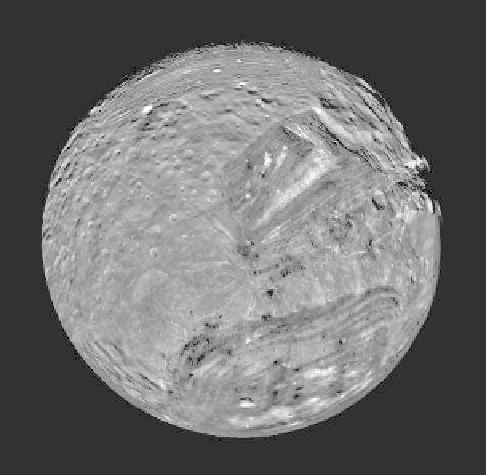Geology Reference
In-Depth Information
Figure 10.3. A composite view of the large moons
of Uranus. Miranda, the innermost of the large
moons, shows the most complex geology, while
the outermost moon, Oberon, preserves the early
bombardment history in the outer Solar System
(NASA Voyager PIA01975).
those of Saturn
s satellites, suggesting a higher propor-
tion of rocky material. Although surface compositions
are predominantly water and carbon dioxide ices
(Grundy et al.,
2006
), their rather low albedos suggest
the presence of some dark material. On the other hand,
methane-ice exposed to photons from the Sun releases
hydrogen and leaves a higher proportion of carbon with
time, as reported by Cruikshank et al.(
1983
) from labo-
ratory experiments.
All of the satellites show impact scars, evidence of
tectonic deformation, suggestions of resurfacing, and
forms of gradation. There appears to be a relationship
between the degree of geologic activity and the satellite
position in orbit around Uranus, with those closest to the
planet having been modi
ed by extensive deformation,
while the outer moons preserve more of the record of
heavy cratering.
The orientation of the Uranus spin axis with respect to
its orbit around the Sun means that the orbits of the major
satellites result in extreme seasonal cycles in which each
pole alternates in being in complete darkness for about
42 years and is then in complete sunlight for the next
42 years. Thus, volatiles in the north pole in its summer
would migrate to the south pole
'
s extreme darkness, and
then the cycle would reverse in the next 42 years.
Miranda. Although this innermost moon is the
smallest of Uranus
'
major satellites, it displays the
most complex geology (
Fig. 10.4
). Miranda
'
s surface
is composed mostly of water-ice. Its geology includes
both old, heavily cratered terrain and younger complex
terrains marked by ridges and grooves, huge scarps,
ovoid
“
racetrack
”
patterns (coronae), and banded
zones, all re
ecting intense tectonic deformation
(
Fig. 10.5
). Many ideas have been proposed to explain
Miranda
'
s surface features, including disruption by dia-
pirs, crustal extension, and one or more huge impacts.
The grabens and other faults (
Fig. 10.6
) are thought to
represent exterior features related to tidal heating gen-
erated from inferred orbital eccentricities and early
'
Figure 10.4. Although Miranda is only 474 km in diameter, parts of
its surface display grabens re
ecting extensive tectonic deformation;
other parts of the surface are heavily cratered and are relatively
unmodi
ed by internal processes (NASA Voyager 2 PIA01490).
interactions with the moon Ariel. Such heating might
have led to diapirs, which could account for Miranda
s
unusual tectonics. Internal heating also could have gen-
erated cryovolcanic resurfacing to form the younger,
smooth plains seen in some parts of the satellite.
Ariel is in synchronous rotation with Uranus and is
immersed in its magnetosphere, which could account for
the darkening on the trailing hemisphere, much like for
Jupiter
'
s moon Europa. Sputtering of ice by ions and
possible implantation of non-ice materials has led to dark-
ening of the surface in comparison with the leading
(lighter) hemisphere. As with Miranda, Ariel
'
s surface
displays ancient heavily cratered terrain and evidence of
tectonic deformation (
Fig. 10.7
), although not nearly as
extensive as that on Miranda. Ariel
'
s density suggests that
it is composed of about half water and half rocky material;
'



